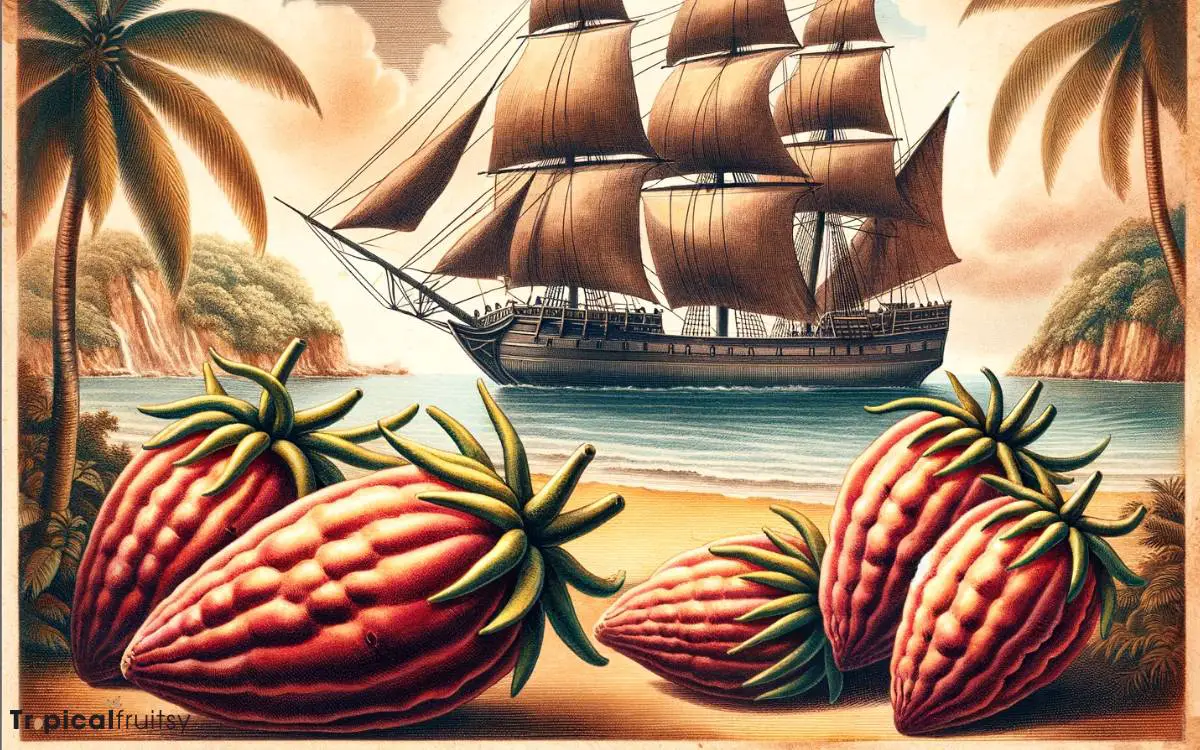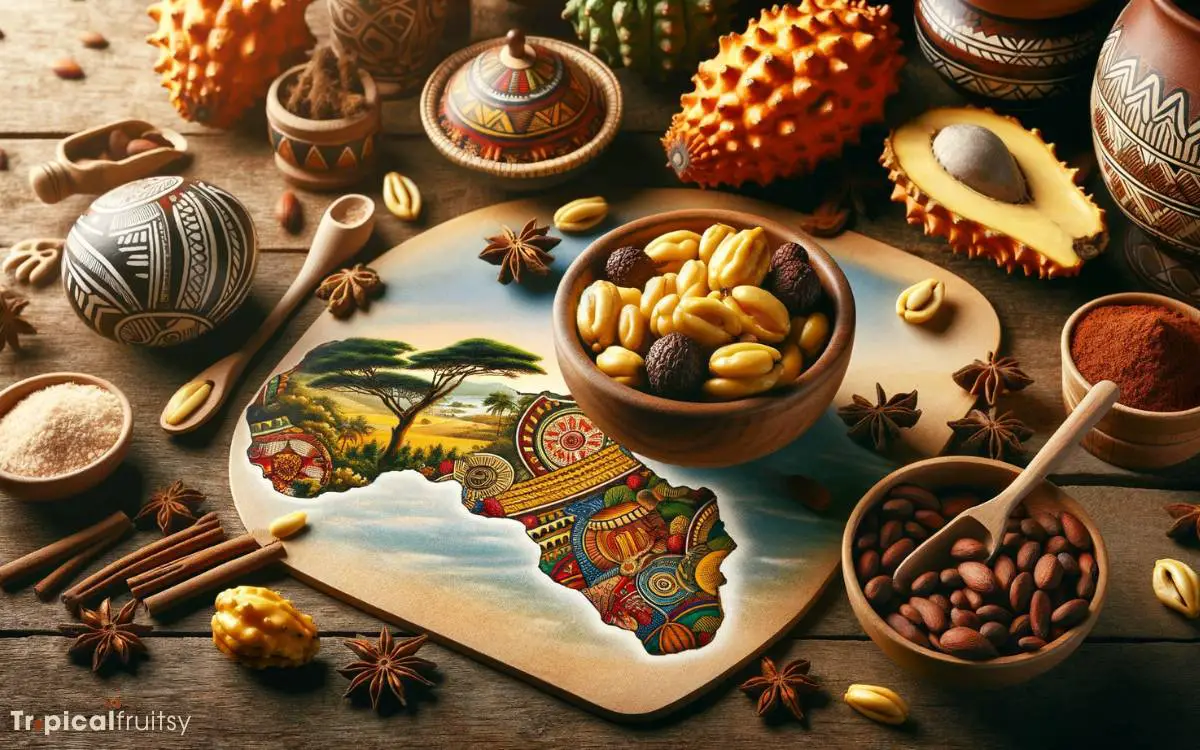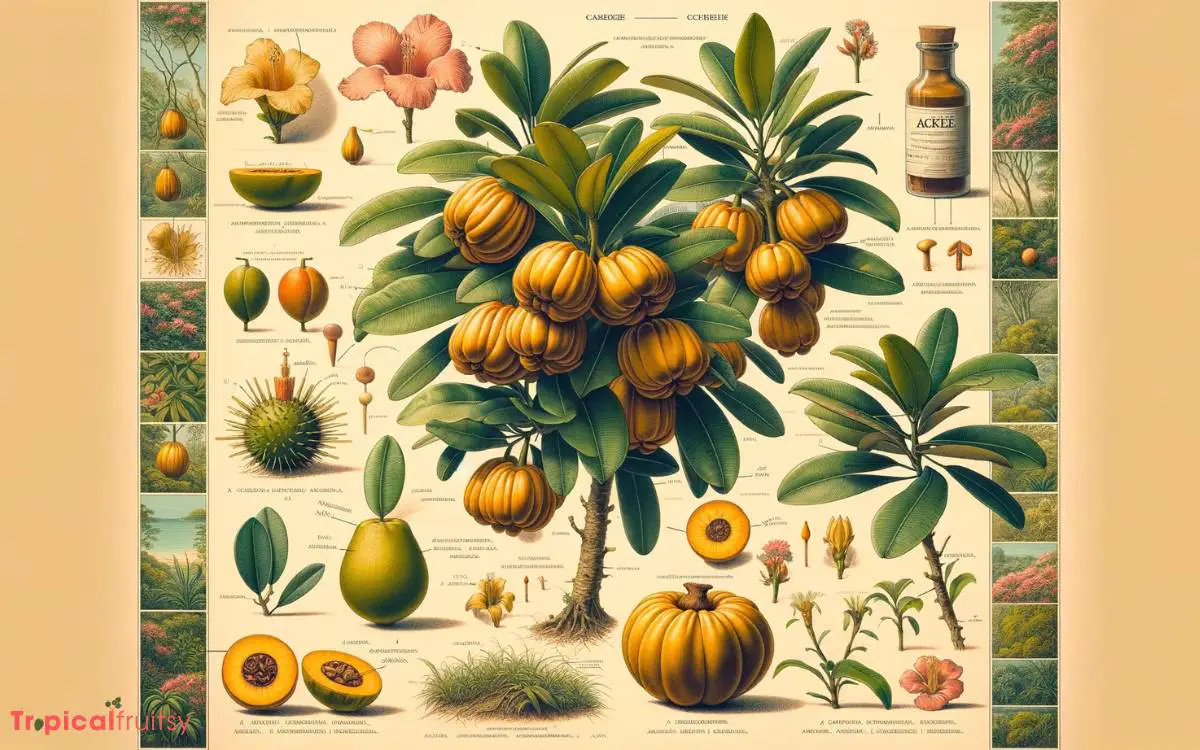Where Did Ackee Originate from? Explained!
Ackee (Blighia sapida), now widely associated with Jamaican cuisine, is a fruit that traces its origins to the tropical regions of West Africa.
This evergreen tree was transported across the Atlantic Ocean during the 18th century, likely via the transatlantic slave trade, and subsequently introduced to the Caribbean.
Ackee’s integration into Jamaican culture and cuisine is profound, with the fruit featuring prominently in the national dish, ackee and saltfish.
Botanically, ackee is a member of the Sapindaceae family, which includes lychee and longan. Its unique appearance and flavor have led to its cultivation and appreciation in other tropical and subtropical regions around the world.
While ackee holds culinary importance, it is also critical to approach its consumption with care due to its toxic properties when improperly prepared.

Key Takeaway
Ackee’s African Heritage

The ackee fruit, Blighia sapida, is indigenous to the tropical regions of West Africa. A member of the Sapindaceae family, it thrives in the humid, warm climates found there.
Ackee’s unique cultural significance is deeply rooted in African heritage, yet it remains underexplored in scholarly discourse. Its name is derived from the West African Akan language, specifically the word ‘anke’ or ‘akye fufo’.
Ackee’s biological properties demand a nuanced understanding, particularly its dual nature as both a nutritious food source and potential toxin.
This dichotomy is reflective of the complex interplay between human culture and natural ecosystems.
The Journey Across Oceans

Ackee’s transatlantic voyage, propelled by the 18th-century slave trade, marked its introduction to the Caribbean and eventual establishment as a staple food in Jamaica.
Originating from West Africa, ackee’s migration is a testament to the complex interplay of human movement and botanical exchange.
The fruit’s resilience and adaptability allowed it to flourish in Jamaica’s tropical climate, harmonizing with the island’s agricultural practices.
Its acceptance into Caribbean cuisine represents a poignant narrative of cultural retention and adaptation among enslaved Africans.
The fruit’s culinary integration, particularly with saltfish, symbolizes a blend of imported and indigenous food traditions, creating a unique diasporic identity.
Ackee’s journey is thus emblematic of the broader Atlantic experience, intertwining ecology with the forced displacement of peoples.
Arrival in the Caribbean

Upon its arrival in the Caribbean, the ackee fruit was quickly integrated into local diets and agriculture, becoming a culinary symbol of Jamaica. The fruit’s assimilation reflects a dynamic process of cultural adaptation and exchange.
Ackee’s introduction is often attributed to West African influence, possibly through the transatlantic slave trade. However, its precise journey remains a subject of historical inquiry.
In Jamaica, ackee found a climatic parallel to its native environment, allowing it to flourish. Its integration into the Jamaican culinary tradition, most notably with saltfish, signifies an interweaving of imported and indigenous food practices.
The fruit’s role in the region’s gastronomy exemplifies the adaptive resilience of transported botanical species and their potential to redefine culinary identities.
Ackee in Jamaican Culture

Jamaica’s national dish, ackee and saltfish, epitomizes the fruit’s profound integration into the island’s cultural and culinary fabric.
Beyond its iconic status, ackee’s presence on the Jamaican table is a daily reaffirmation of cultural identity and communal memory, reflecting a synthesis of indigenous Taino, African, and European food traditions.
The preparation of ackee, often paired with codfish imported historically due to colonial trade patterns, speaks to a resourceful adaptation over generations.
Ackee has transcended its role as sustenance to become a symbol of Jamaican resilience and creativity. As such, it holds a revered position in the social and gastronomic realms of the country.
Moving from cultural aspects to scientific details, it is essential to examine the botanical profile of ackee to appreciate its significance fully.
The Botanical Profile

The ackee fruit, scientifically named Blighia sapida, is a member of the Sapindaceae family, known for its distinctive pear-shaped capsules and toxic properties if consumed unripe.
In examining its botanical profile, several aspects stand out:
- Rare Dichotomy: The fruit’s unique trait of being both a delicacy and a danger resonates with the precarious balance found in nature.
- Vibrant Hues: Ackee’s red to yellow hues, symbolizing vitality and caution, contrast sharply with the black seeds nestled within.
- Cultural Emblem: As Jamaica’s national fruit, ackee embodies rich cultural heritage, invoking pride and a sense of identity.
- Medicinal Potential: Research into ackee’s hypocholesterolemic properties stirs hope for future therapeutic applications.
This intricate botanical character sets the stage for exploring ackee’s global spread and cultivation.
Global Spread and Cultivation

Originating from West Africa, ackee was transported to Jamaica in the 18th century and has since become integral to various tropical and subtropical regions’ agriculture.
Its proliferation is closely tied to historical patterns of trade and colonialism, which facilitated the exchange of flora and fauna across continents.
Ackee’s adoption into Caribbean culture, particularly in Jamaica, is emblematic of this botanical and cultural exchange.
Cultivation practices have evolved to accommodate the plant’s specific needs, such as warm climates and well-drained soils.
The tree’s economic significance arises from its fruit, which, when prepared correctly, is a staple ingredient in local cuisines.
The cultivation of ackee now reflects a complex interplay of historical movements and contemporary agricultural practices within the diasporic communities it nourishes.
Ackee’s Culinary Uses

Ackee’s culinary applications are numerous, with its distinctive fruit featuring prominently in a variety of traditional dishes.
This pear-shaped delicacy is a cornerstone of West African and Caribbean cuisine, where its preparation and consumption are deeply embedded in the cultural fabric.
Ackee is celebrated for its versatility and unique flavor profile that, when cooked, is often compared to scrambled eggs.
- Ackee and Saltfish: Jamaica’s national dish, pairing sautéed ackee with salted cod, onions, and spices.
- Vegetable Stews: Ackee acts as a textural centerpiece in hearty, spiced stews.
- Side Dishes: Blended with tomatoes and bell peppers, it complements meats and fishes.
- Fritters: Transformed into savory fritters, ackee becomes a delicious snack or appetizer.
The significance of ackee in contemporary culinary traditions extends beyond taste, symbolizing a rich cultural history.
Is the Origin of Ackee Related to Its Expensive Price?
The origin of ackee is not directly related to its expensive price. Ackee is a tropical fruit native to West Africa, and its pricing is influenced by factors such as demand, supply, and import costs. Ackee pricing explained now can help consumers understand the reasons behind its high cost.
Contemporary Ackee Significance

As the national fruit of Jamaica, the ackee has transcended its botanical origins to become a symbol of Jamaican identity and heritage.
This cultural emblem not only anchors traditional cuisine but also propels a significant export industry, reflecting its dual role in economic and social spheres.
The fruit’s cultural and economic weight demands a nuanced understanding of its integration into the fabric of contemporary Caribbean society.
National Fruit Emblem
Commonly celebrated as Jamaica’s national fruit, ackee holds a revered position in the country’s cultural and culinary identity.
Though native to West Africa, ackee has become emblematic of Jamaican heritage, embodying a story of migration, adaptation, and resilience.
Its significance transcends mere sustenance, reflecting the soul of a nation through:
- A symbol of enduring strength—ackee’s journey and establishment in Jamaica parallel the history of its people.
- A cultural unifier—ackee is a staple in Jamaican cuisine, shared across socio-economic boundaries.
- An economic pillar—it supports local agriculture and is integral to food trade.
- A centerpiece of tradition—ackee is essential in national dishes, particularly ackee and saltfish, the national dish.
Culinary Cultural Icon
The fruit of the ackee tree has cemented its status as a culinary cultural icon in Jamaica, reflecting its contemporary significance in national identity and daily life.
Ackee’s integration into the fabric of Jamaican cuisine is not merely a reflection of gastronomic preference but a symbol of the island’s history and resilience.
Its prominence in the national dish, ackee and saltfish, underscores its cultural importance and the way it encapsulates the melding of indigenous and imported influences.
Contemporary culinary practices involving ackee demonstrate its versatility and adaptability, with its usage extending beyond traditional recipes to innovative gastronomic creations.
Ackee thus remains a steadfast emblem of Jamaican heritage, continuously reaffirming its role within the social and cultural tapestry of the nation.
Ackee Export Industry
Building upon its cultural significance, Jamaica’s export of ackee contributes significantly to the country’s economy, reflecting the fruit’s global reach and economic impact.
The ackee export industry is not merely a commercial enterprise; it is a vessel of Jamaican heritage, delivering a taste of the island’s soul to distant lands.
Consider these points:
- Ackee exports are a testament to Jamaica’s agricultural prowess and its ability to meet international safety standards.
- The fruit’s journey from local markets to foreign shelves embodies Jamaica’s entrepreneurial spirit and capacity for global trade.
- As a niche product, ackee commands a premium price, supporting the livelihoods of Jamaican farmers and processors.
- The presence of ackee in diaspora communities serves as a poignant reminder of the enduring bonds of heritage and identity.
Each element underscores the deep-rooted significance of ackee as a symbol of Jamaican culture and economic resilience.
Conclusion
The ackee fruit’s migration from West Africa to global prominence is a testament to cultural interchange and globalization.
Its integration into the fabric of Jamaican culture and cuisine underscores the adaptive nature of botanical species and human culinary practices.
Significantly, Jamaica’s export of canned ackee represents over $10 million annually, illustrating the economic impact of this culturally resonant fruit.
Ackee continues to flourish as a culinary delicacy and symbol of heritage in diverse societies worldwide.






